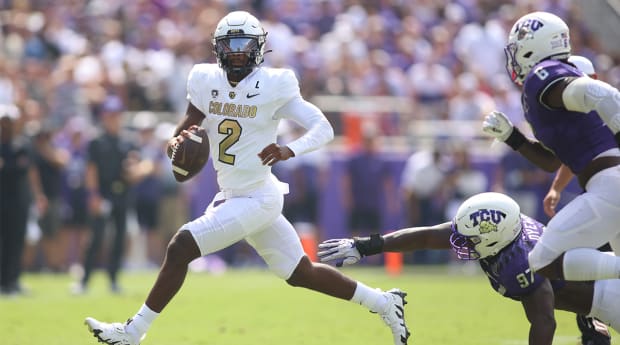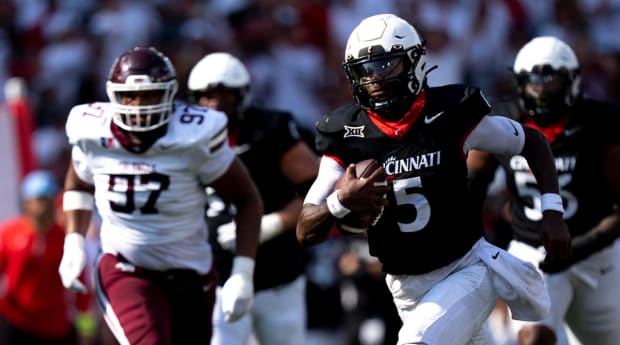Forty names, games, teams and minutiae making news in college football, where misfortune at LSU and Clemson has moved Missouri and Memphis to the top of the Tiger Power Ratings (temporarily):
Second Quarter: Dabo Swinney and Clemson Look Outdated | First Quarter: Colorado Seizes Moment
Third Quarter: Pac-12’s Terrific Start and Terrible Timing
If George Kliavkoff (21) could bear to watch from his fortress of solitude, this past weekend had to be incredibly conflicting. The commissioner of the Pac-12 Conference saw his teams improve to 13–0, an emphatic statement about what this league can be this season. And yet. The Pac-12 is healthy and dying at the same time, starting a swan-song season that will be followed by 10 schools dispersing to points elsewhere—far elsewhere for the most part.
The present is exciting. The future is nonexistent.
As has been chronicled for the past six weeks—and, really, the 13 months preceding that—the primary culprits are disastrous leadership and faulty vision. But there is some lousy luck involved as well, given the way everything has timed out.
The Pac-12 avoided ugly opening losses (22) to the likes of Montana, Utah State, Nevada and Hawai‘i. Those had been staples of early September in years past. Pac-12 teams covered the spread in 10 of those first 13 games.

Albert Cesare/USA TODAY Sports
The Pac-12, for once, hung some power-conference skins on the wall (23) by beating TCU and Florida. The league was 2–9 against power-conference opponents in season openers the previous five years, and winless since 2019.
The Pac-12, for once, saw the perceived bottom of the league rise up (24), with California, Colorado and Stanford all posting big road wins. They were picked to finish ninth, 11th and 12th in the league, respectively.
But those are short-term wins. There is no long-term advancement for the league.
Same with the bold hires of Deion Sanders, Kenny Dillingham and Troy Taylor this year; of Kalen DeBoer, Dan Lanning and Lincoln Riley last year. Those ultimately will help other leagues, not the Pac-12.
The influx of quarterback talent via the portal the past two seasons has been spectacular: Heisman Trophy winner Caleb Williams at USC, Bo Nix at Oregon, Michael Penix at Washington, Shedeur Sanders at Colorado, DJ Uiagalelei at Oregon State, Cameron Ward at Washington State, Ben Finley at California. And here come a couple of five-star freshmen getting immediate playing time in Dante Moore at UCLA and Jaden Rashada at Arizona State. Currently six of the top 18 quarterbacks in the nation in pass efficiency are from the Pac-12; the SEC is second with four, and no other league has more than two. But the Pac-12 gets only three more months with that group.
Watch live sports with Fubo. Start your free trial today.
Beyond the obvious big-picture issues—the Larry Scott tenure, the fumbling of media-rights negotiations, the failure to take care of the conference’s biggest brands—The Dash wonders whether things might have been different if this renaissance had launched a year or two earlier. What if Chip Kelly had gotten UCLA ramped up faster? If Washington hadn’t gone through the Jimmy Lake mistake? If Arizona State had acted a year earlier to fire Herm Edwards? If USC had done the same with Clay Helton? If David Shaw had moved on from Stanford sooner?
But those are hypothetical questions that don’t change the reality of where the Pac-12 resides. The football lease is up at the end of the year, might as well throw the biggest ranger they can between now and then.
Week 1 Debut Check-in
Last week The Dash previewed a bunch of head coaches, coordinators and quarterbacks who were under the microscope to start the season. Let’s take a look at the best and worst of each of those after one game.

Tim Heitman/USA TODAY Sports
Best debut by a quarterback at a new school: Emory Jones (25), Cincinnati. After losing the starting jobs at Florida and Arizona State in previous years, Jones arrived at school No. 3 for a sixth season of college ball. Early returns suggest he will flourish in Scott Satterfield’s QB-friendly offense. Jones produced a school-record seven touchdowns in a wipeout of Eastern Kentucky, five passing and two running, on just 32 combined runs and passes.
Biggest struggle by a quarterback at a new school: Jeff Sims (26), Nebraska. The Georgia Tech transfer ran for 91 yards, but his passing remains suspect and inconsistent. Sims threw three interceptions in the game—one in the end zone to kill a scoring drive and one that gave Minnesota the ball for what would be a game-winning drive. Smith’s lone TD pass came off a busted trick play in which he had a receiver wide open. The Cornhuskers will need much better from Sims in Boulder, Colo., on Saturday.
Best debut by a new coordinator (non–Sean Lewis division): Will Stein (27), Oregon. The opponent was FCS Portland State, but still. Freshly arrived from UTSA (which scored just 14 points in his absence), Stein directed the Ducks to 81 points and 10.1 yards per play, both of which currently lead the nation.
Biggest struggle by a new coordinator (non–Garrett Riley division): Matt Powledge (28), Baylor. The Bears were gouged for 42 points, 441 yards and 6.4 yards per play by huge underdog Texas State. That included surrendering eight plays of 20 yards or more, the most of any power-conference team that has played only one game to date.







